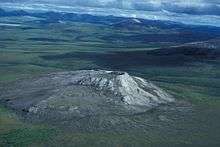Arctic Alaska
Arctic Alaska, also referred to as Far North Alaska, is a vast region of Alaska extending from around the Arctic Circle to the Arctic Ocean.
Cities
- 🌍 Anaktuvuk Pass
- 🌍 Bald Head
- 🌍 Coldfoot — very small town, although an important stop with services on the Dalton Highway
- 🌍 Deadhorse — town of oil operations at the northern end of Dalton Highway, just a few miles south of Arctic Ocean coast
- 🌍 Elim
- 🌍 Golovin
- Moses Point
- 🌍 Nome
- 🌍 Shaktoolik
- 🌍 Solomon — small town between Nome and Council, along the Nome-Council Road and Iditarod Trail
- 🌍 Teller
- 🌍 Unalakleet - large town along the Iditarod Trail and Norton Sound
- 🌍 Utqiaġvik (Barrow) — the northernmost town in the United States
- Walla Walla — a town along the Iditarod Trail
- 🌍 White Mountain
- 🌍 Wiseman — small town 3 miles off Dalton Highway, with several historical buildings
Other destinations

- 🌍 Arctic National Wildlife Refuge is accessible from the tiny native settlement 🌍 Kaktovik
- 🌍 Gates Of The Arctic National Park - home to six Wild and Scenic Rivers that offer opportunities for unparalleled wilderness experiences
- 🌍 Little Diomede — the westernmost point of North America is a small island in the Bering Strait almost on the International Date Line
- Western Arctic National Parklands - Western Arctic National Parklands is a unit which includes:
- 🌍 Bering Land Bridge National Preserve - During the Ice Age the people of Beringia were separated.
- 🌍 Cape Krusenstern National Monument - stretches 70 miles along the Chukchi Sea shoreline
- 🌍 Kobuk Valley National Park and Preserve – Ancient arctic sand dunes and a sub-arctic river that traverses the boreal forest, this park harbors archeological sites more than 10,000 years old, and supports small communities of inland Inupiat peoples.
- 🌍 Noatak National Preserve – As one of North America's largest mountain-ringed river basins with an intact ecosystem, the Noatak River environs features some of the Arctic's finest arrays of plants and animals.
Understand
Talk
Native Inuit and Yupik languages are spoken in many small towns. However, English is the primary language, spoken by most Alaska Natives except perhaps the most elderly. There are only a handful of persons fluent in any other languages.
Get in
The main method of arriving in Arctic Alaska is by air. Alaska Airlines offers almost daily commercial flights to the cities of Barrow (Utqiaġvik) (BRW IATA) and Deadhorse (SCC IATA). Additionally, many small turboprop services offer service to towns/airstrips throughout the region, such as Elim Airport (ELI IATA).
The Dalton Highway connects Deadhorse and the Prudhoe Bay oilfield with Fairbanks. The highway is one of only two roads across the Arctic Circle in North America and provides a unique experience, running through the Brooks Range, Atigun Pass, North Slope and Coastal Plain. The highway can be accessed via the Steese and Elliot highways from Fairbanks.
Get around
Small planes, including ones with skis or pontoons, are the best way of accessing this remote and vast region. Most small towns have an airstrip or are located near a lake. Air travel in this region provides spectacular views of remote terrain.
The Dalton Highway runs through the Brooks Range, North Slope, and Coastal Plain to Deadhorse. This road is a great way to view these remote areas without a plane. Additionally, several roads extend outward from Barrow into surrounding areas.
Sled dogs may be used in wintery months, but the extreme cold of this region in the middle of the winter can be very treacherous.
See
- Inupiat Heritage Center - On the rooftop of the world, the Iñupiat Heritage Center in Utqiaġvik tells the story of the Iñupiat people
Itineraries
Do
Eat
Drink
Sleep
In remote villages or towns too small to have hotels, it may be possible for schools to accommodate visitors, sometimes in classrooms converted into makeshift sleeping quarters.